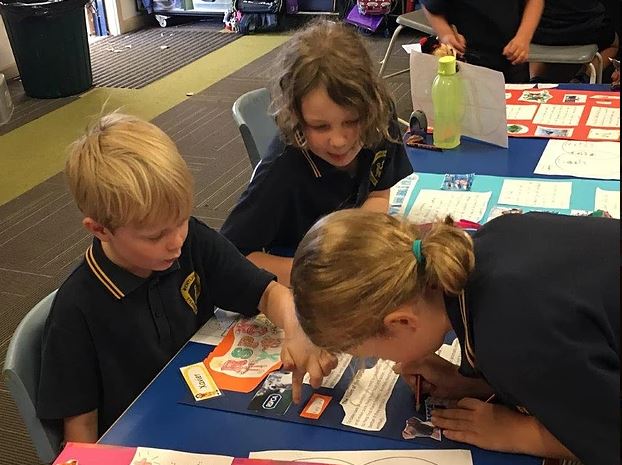Principals and school leaders
Home » Principals and school leaders
Principals carry overall responsibility for the reading instruction in schools. However, many principals have not been teachers of early reading and do not have the specialist knowledge required to make evidence-based decisions about reading instruction. Once principals are equipped with this knowledge, the next challenge is to make the changes necessary to ensure every classroom has expert teachers providing effective, evidence-based reading instruction. The FIVE from FIVE website provides information about the evidence on effective reading instruction, including the five keys to reading and explicit instruction.
Putting research into practice for teaching beginning readers: One school’s move to implement evidence based instruction.
By Principal, Steven Capp, BWPS
Primary school teachers with the vital role of teaching children to read must know the most about this cognitive process and the effective instruction that facilitates it.
The research that supports the Simple View of Reading—reading as the product of word reading and language comprehension—is overwhelming. The idea that five main components, six if you include oracy, underpin reading is undisputed. They are:
- Phonemic Awareness
- Phonics
- Fluency
- Vocabulary
- Comprehension
Therefore all teachers should be able to assess and teach to these areas.
All literacy teaching blocks at Bentleigh West Primary School (BWPS), are designed around these ‘Big 6’ components. Literacy blocks include rich texts and specific lessons to build vocabulary and comprehension skills and also include an explicit focus on phonemic awareness and phonics.
At BWPS, phonemic awareness and phonics needed extra attention as these areas are crucial for decoding skills and were the least understood by most of our teachers and school leaders, including myself. I suspect this may be true of many schools across Australia for reasons that Jennifer Buckingham, Pamela Snow and others have so elegantly outlined in a number of presentations and blogs.
Early screening of phonemic awareness is essential to determine whether children have the fundamental skills in early reading and spelling acquisition. Screening all students before they start their foundation year or at the very beginning of the foundation year allows teachers to identify skills to explicitly teach and devise practice that enable the transition to decoding.


Teachers can also see how quickly students respond to this explicit instruction and decide very early on who may need extra sessions to master these skills before any hint of reading failure. The idea is to catch students before they fail.
To the students, this experience is nothing more than rhyming and manipulation games, but behind these games is careful planning around the skills that need to be mastered that have been uncovered by the screening process.
Students who show proficiency in these main areas of phonemic awareness are then ready to be explicitly taught phonics. At BWPS we thought we were already teaching phonics, until we understood Systematic Synthetic Phonics (SSP). Systematic Synthetic Phonics starts with the most basic letter sound correspondence and gets increasingly more complex as the students master more and more of the code. We also ensured this was taught using a whole school approach.
Phonics and phonemic awareness warm ups and explicit teaching is built into our literacy blocks every day, as students need practice recognizing the 44 phonemes from symbol to sound and sound to symbol to become proficient. We have also found that students who are lucky enough to more readily pick up decoding skills benefit from being explicitly taught phonic rules as it helps spelling and writing and gives them access to their intellectual right to understand their language.
Once students show they can decode simple consonant-vowel-consonant words and know some basic sight words, like ‘said’, they are ready for their first decodable reader.
These are readers designed to the scope and sequence of phonics instruction and students can practice the rules and words they have been explicitly taught. These readers become increasingly more complex. Students are never asked to practice anything they haven’t been explicitly taught. This ensures no guessing and a high success rate to build self-efficacy.
Students also take home a real book from the library. Here they can be more autonomous in their reading choices: Read what they can, discuss with parents and, more importantly, be read to, so listening comprehension skills and background knowledge are primed, ready to support reading comprehension when the big 6 are integrated and the student accesses more and more text for themselves.
This method has seen a drastic improvement in all students’ reading ability in the Foundation Year.
In 2014 teacher judgement showed 24% of Foundation students achieving 6 months or more above the level in a cohort of 73. In 2015 teacher judgement was 62% of students 6 months or more above the level in a cohort of 70.

Prior to the implementation of evidence-based instruction, students were given a reader on day one of prep and asked to remember the pattern of the sentences and guess from the picture. There were students who would say the sentences without looking at the page; this is hardly reading.
Principal Steven Capp, Bentleigh West Public School

Implementing evidence-based practice is the most satisfying work our school has ever done and it has benefitted all, and harmed none.
Principal Steven Capp, Bentleigh West Public School
ACER PAT Reading testing of this same cohort the following year confirmed 42% 12 months above the expected level. Foundation judgments of 6 months or more above the level have held in 2016 at 69% in a cohort of 70. There are no students reading below expected level in the 2015 and 2016 cohorts that have been at BWPS from the beginning of Foundation Year.
The 2017 NAPLAN results have revealed that at Grade 3 we achieved our third highest result for reading (267—we have achieved 272 twice before). Reading improved from 459 in 2016 to 467 in 2017. We achieved our highest results for writing (453) and Spelling (438) since NAPLAN started in 2008. Writing improved from 441 in 2016 to 453 in 2017 and Spelling 429 in 2016 to 438 in 2017. This is still below what is expected for our Student Family Occupation Index, but signs we are on the right track in achieving results we have never seen at the school since NAPLAN began in 2008. Grade 3 to 5 growth was really impressive and we got improvement in reading from 524 (2016) – 537(2017) and Spelling went from 503 (2016) to 516 which was up with our highest results. Our school had no exemptions for grades 3 and 5, all students were encouraged and expected to sit the NAPLAN test. Next year I expect to see more improvement particularly in reading and spelling.
Parents who have older children at BWPS and younger children who have been exposed to research-based methods since 2015 often stop me and marvel at the difference. They constantly tell me they wish these methods had been in place for their older children.
What used to happen at BWPS was not evidence-based instruction, but we were only practicing what we knew. Prior to the implementation of evidence-based instruction, students were given a reader on day one of Prep and asked to remember the pattern of the sentences and guess from the picture. There were students who would say the sentences without looking at the page; this is hardly reading.
We used to do monthly running records based on the ‘three cueing system’ —working out unfamiliar words using semantic, syntactic, and graphophonic ‘cues’— which would give teachers no detailed evidence of what instruction was needed, as the leveled texts had no consistency in sequence. In levelled readers it is common for a child’s first reader to contain a mixture of open, closed, and controlled ‘r’ syllables with a silent e thrown in, through to words with /igh/ and /ai/ graphemes, with no explicit teaching of these symbols or sounds.
If students couldn’t read we would shrug our shoulders and hope that another month of the same instruction, or more intensive doses of the same instruction, would somehow fix the issue. It very rarely did, so I wasn’t surprised to read that the three cueing system has no research to support its existence.
We were encouraged to teach to guess words from deduced meaning. I think it is more important to decode the words that the author wants you to read.
In the meantime, the number of students needing reading support would balloon every year throughout the school, as academic vocabulary increases and the ability to commit every word and meaning to memory fails, and guessing becomes harder.
Those monthly running records would keep coming up and we would waste precious teaching time on assessments that told us very little. Compare this with a five minute phonemic awareness or phonics screener that tells you exactly what the students don’t know and teachers who are trained how to teach the content.
Implementing evidence-based practice is the most satisfying work our school has ever done and it has benefitted all and harmed none.
For those wanting to know where to start with screeners, Macquarie Online Test Interface (MOTIf), Dynamic Indicators of Basic Early Literacy Skills (DIBELS) and the UK phonics screening check are great places to start. All are free.
